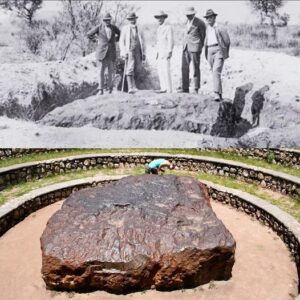Introduction
Nestled in the remote region of Grootfontein, Namibia, lies one of Earth’s most fascinating cosmic relics—the Hoba meteorite. Discovered in 1920 by a local farmer, this massive iron slab has since become a scientific marvel, attracting researchers and tourists alike. Weighing an estimated 60 tons, the Hoba meteorite is the largest known meteorite that has remained intact on Earth. Its sheer size, unusual composition, and enigmatic lack of an impact crater have puzzled experts for decades. In this article, we’ll explore the remarkable features, scientific mysteries, and historical significance of this ancient visitor from space.
Discovery and Location
A Remarkable Find
In 1920, a Namibian farmer named Jacobus Hermanus Brits discovered an unusually large metal object on his land. Upon further inspection, scientists confirmed that this was no ordinary rock but a meteorite composed primarily of iron and nickel. The discovery of the Hoba meteorite captured global attention, marking it as an extraordinary natural wonder.
The Setting: Grootfontein, Namibia
The meteorite remains in its original resting place near the town of Grootfontein. It’s now a protected national monument, attracting thousands of visitors each year. Surrounded by a preserved natural setting, the Hoba meteorite is a powerful reminder of the forces beyond Earth’s atmosphere that have shaped our planet.

Composition and Structure
The Iron Giant
Composed of about 82% iron and 16% nickel, with small traces of other metals, the Hoba meteorite is classified as an ataxite—a rare type of iron meteorite. Its composition suggests it originated from the core of an ancient celestial body, possibly an asteroid. This high iron content gives the meteorite its remarkable weight, estimated at around 60 tons, and a distinct metallic sheen that has withstood the elements for millennia.
Unusual Shape and Size
One of the most striking aspects of the Hoba meteorite is its nearly flat, tabular shape, measuring about 2.7 meters (8.9 feet) long and 2.7 meters wide. This flattened structure is unusual for meteorites, which are typically irregular in shape due to high-temperature impacts and breakage upon entering Earth’s atmosphere. The shape of the Hoba meteorite likely contributed to its gentle landing, influencing how it embedded into the earth without causing significant impact damage.
The Mystery of the Missing Crater
Low Angle and Low Velocity
Despite its immense size and weight, the Hoba meteorite left no impact crater, an anomaly that has intrigued scientists. The leading theory suggests that the meteorite entered Earth’s atmosphere at a very low angle, reducing its velocity and allowing it to glide to the ground rather than crash. This hypothesis is further supported by the meteorite’s flat, aerodynamic shape, which may have allowed it to slow down more than a typical meteorite would.
A Soft Landing?
Some researchers also theorize that atmospheric resistance played a role in slowing the meteorite to a point where it could “land” rather than collide with the surface. Combined with its low approach angle, this may explain how such a massive object could settle gently into the soil. This phenomenon makes Hoba unique among known meteorite impacts.

Scientific Significance
Insights into the Early Solar System
The Hoba meteorite offers valuable clues about the early solar system. As a chunk of primordial metal likely originating from the core of an asteroid, it provides a glimpse into the building blocks of planetary formation. Studying the meteorite’s composition helps scientists understand the conditions and materials present in the solar system’s early days.
An Educational Resource
In addition to its scientific value, the Hoba meteorite serves as an educational resource, sparking interest in astronomy, geology, and space science. The site now includes informational plaques and signage, allowing visitors to learn about the meteorite’s origins, structure, and the geological forces involved in its journey to Earth.
Cultural and Historical Impact
A National Monument of Namibia
Recognizing its importance, the Namibian government declared the Hoba meteorite a national monument in 1955. Since then, efforts have been made to preserve the site and manage it as a cultural and educational destination. The Hoba meteorite has become an iconic symbol of Namibia’s unique natural heritage.
Tourism and Economic Impact
The Hoba meteorite attracts numerous tourists each year, benefiting the local economy and fostering interest in Namibia’s natural and historical treasures. Its isolated location has turned Grootfontein into a notable spot on the map for curious travelers and science enthusiasts alike.

Conclusion
The Hoba meteorite stands as a marvel of both natural and cosmic history. Its immense weight, unusual shape, and the mystery of its gentle landing make it a unique subject for scientific exploration. Whether you are a geology enthusiast, a space buff, or a casual traveler, the Hoba meteorite offers a rare opportunity to connect with the ancient past of our universe. As we continue to learn more about this remarkable object, it serves as a powerful reminder of the forces that exist beyond our planet and the mysteries they bring to Earth.
